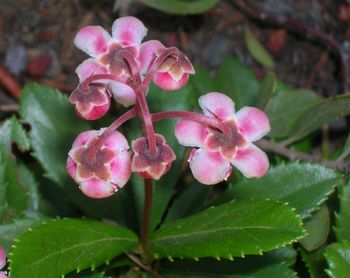Pipsissewa
Other names : Chimaphilla umbellata, Prince's pine, Umbellate wintergreen
A small, perennial evergreen native to much of southern Canada and the northern United States. Its scientific name literally means "winter loving," but its leaves are collected in late summer. Dried leaf are used, although all parts of the plant including stems are active.The entire plant is used as medicine.
Contents
Special Precautions of Pipsissewa
Leaves poulticed on the skin may induce redness, blisters, and peeling. Arbutin hydrolyzes to the toxic urinary antiseptic hydroquinone.
Constituents
The glycosides arbutin, ericolin and chimophilin, excreted in the urine as disinfectant substances similar to uva ursi, sitosterol, ursolic acid
Properties
Alterative, antibacterial, astringent, diaphoretic, rubefacient, diuretic, stimulant , laxative, tonic
Health Benefits and Uses of Pipsissewa
- Pipsissewa was used by indigenous peoples for its astringent properties and was much used by many tribes of native North American Indians to induce sweating and treat fevers, including typhus.
- Noted for producing diuretic action without irritant side-effects.
- By increasing urine flow, Pipsissewa increases the removal of waste products from the body. Removing waste products from the body often benefits the joints, making this an excellent remedy for arthritis and gout.
- The plant contains hydroquinones which have a pronounced disinfectant effect within the urinary tract and modern day herbalism mainly employs the plant to treat urinary problems such as cystitis and urethritis.
- Prolonged use of the leaf tea is said to dissolve bladder stones and dropsy.
- It has been recommended for scrofula and rheumatic problems.
- With medical supervision, it can be used for dropsy, albuminuria, hematuria, chronic kidney problems, and gonorrhea.
- Externally, a tea or poultice made from the plant can be applied to ulcers, sores, tumors, blisters, and swellings, muscle cramps.
- Native Americans used leaf tea for backaches, coughs, stomachaches, as a blood purifier, diuretic; drops used for sore eyes. Leaves were smoked as a tobacco substitute.
- Early research with animals suggests that Pipsissewa may have the ability to lower blood sugar levels.
- Some Plateau Indian tribes used a boil of prince's pine to treat tuberculosis.
- The leaves have very little scent until they are rubbed to release a pleasant but mildly "puckery" odor. It is currently used as a flavoring in root beer production, and in candy. The plant is used in perfumery because of its delicate scent.
References
- Launert. E. Edible and Medicinal Plants. Hamlyn 1981 ISBN 0-600-37216-2
- Hunn, Eugene S. (1990). Nch'i-Wana, "The Big River": Mid-Columbia Indians and Their Land. University of Washington Press. p. 352. ISBN 978-0-295-97119-3.
- Chevallier. A. The Encyclopedia of Medicinal Plants Dorling Kindersley. London 1996 ISBN 9-780751-303148
- Moerman. D. Native American Ethnobotany Timber Press. Oregon. 1998 ISBN 0-88192-453-9
Very comprehensive but terse guide to the native uses of plants.
